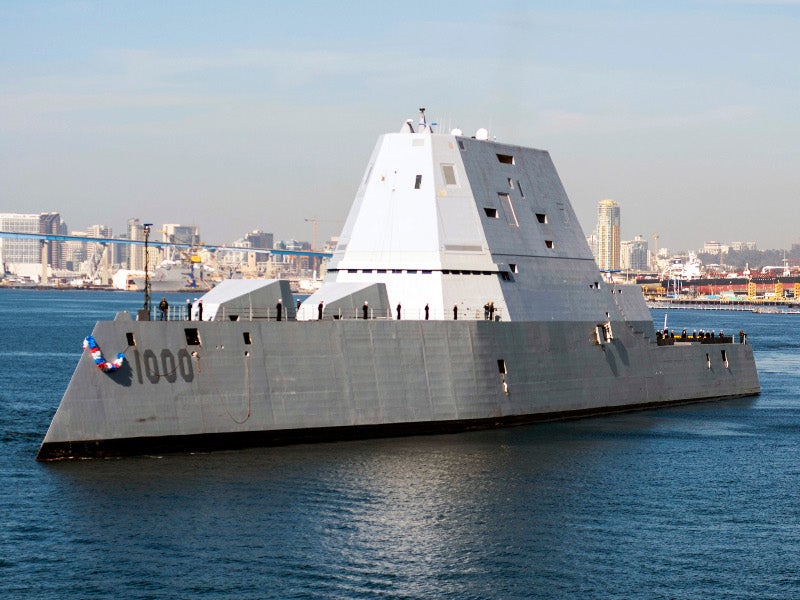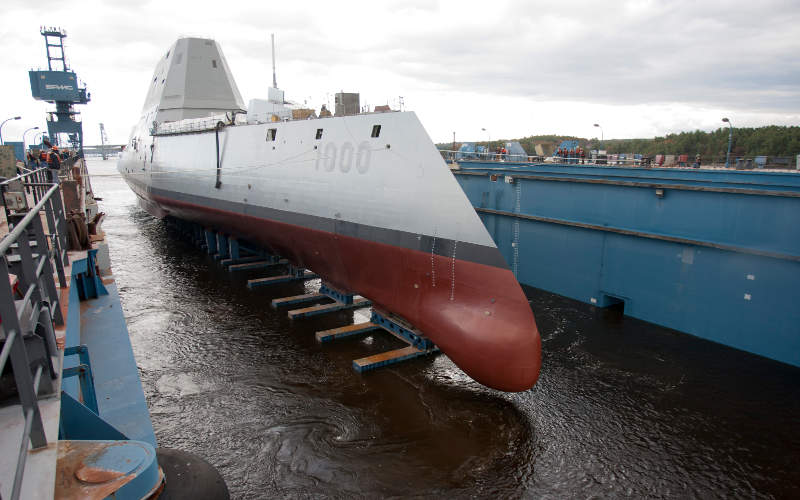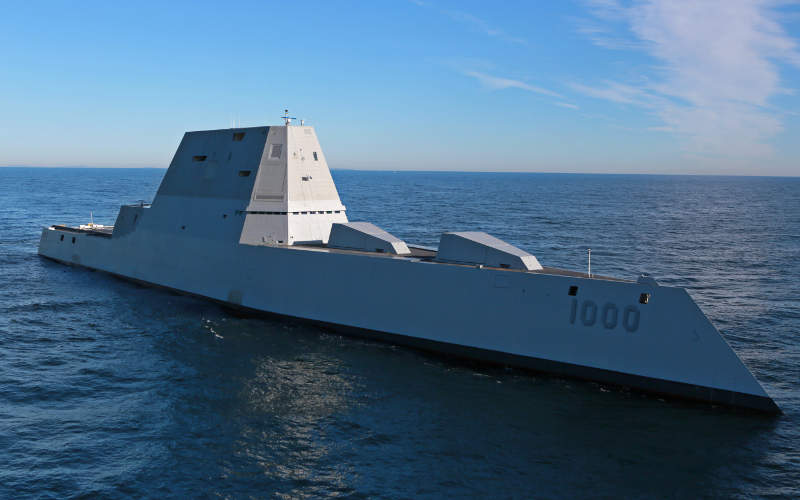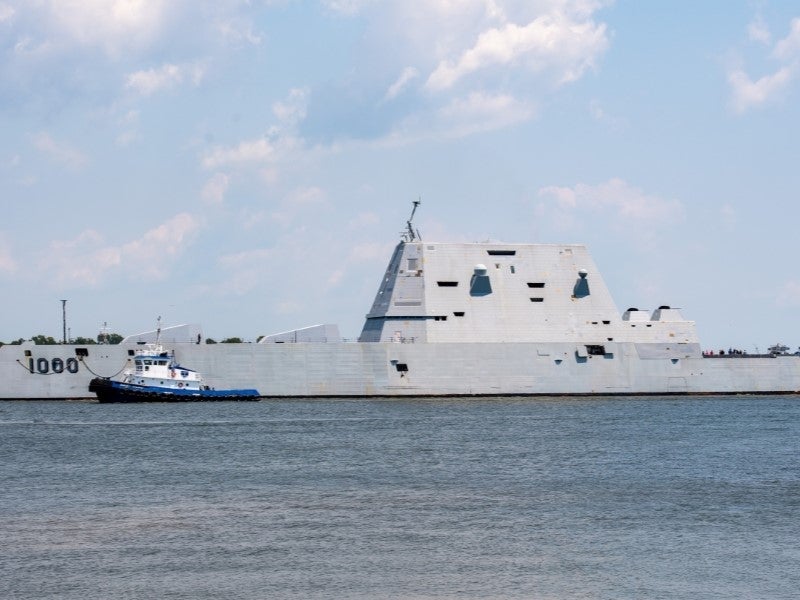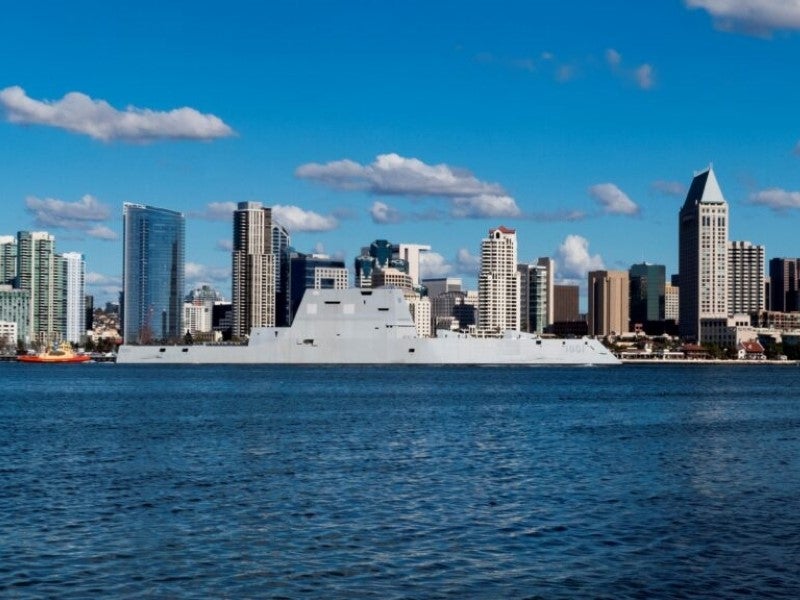The DDG 1000 Zumwalt-class guided missile destroyers are one of the world’s most advanced surface combatant warships.
The vessels are developed as part of the DD 21 programme, which was renamed DD(X) by the US Department of Defense in November 2001.
DDG 1000 replaces the DD 21 Zumwalt programme, which was for a class of 32 multimission destroyers to replace Oliver Hazard Perry-class frigates and Spruance class destroyers from 2012.
In April 2002, Huntington Ingalls Industries (HII) (previously Northrop Grumman Ship Systems), was selected as the lead design agent for DD(X). The company led the ‘gold team’, which included Raytheon Systems Company as the systems integrator.
The ‘gold team’ proposal incorporates ‘blue team’ leader Bath Iron Works (BIW), a General Dynamics company, as a subcontractor for design and test activities. Other major subcontractors include Lockheed Martin, BAE Systems Land and Armaments (formerly United Defense) and Boeing.
The destroyers are currently being integrated with Conventional Prompt Strike (CPS) hypersonic missile system.
The CPS system will provide additional strike warfare capability to the warships.
DDG 1000 Zumwalt-class design
The DDG 1000 Zumwalt-class vessels measure 610ft in length and have an 80.7ft beam. They have a displacement of 15,997 tonnes (t) with a sustained speed of 30 knots.
The vessels can accommodate a crew of 197.
DDG 1000 has a ‘tumblehome’ hull form, a design in which the hull slopes inward from above the waterline.
This significantly reduces the radar cross-section since such a slope returns a much less defined radar image rather than a more hard-angled hull form.
Requirements for the integrated deckhouse engineering development model (EDM) is that it is fully electromagnetic compatibility-shielded with reduced infrared and radar signatures.
Measures to fulfil these conditions include an all-composite superstructure, low-signature electronically steered arrays, an integrated multifunction mast, and low radar and infrared signatures.
Northrop Grumman completed DDG 1000 system design and 11 EDMs and the system-wide critical design review was completed in September 2005.
The EDMs included an advanced gun system (AGS), integrated power system, composite deckhouse, a peripheral vertical launch system (PVLS), integrated sonar system (with advanced towed array and high-frequency active sonar) and dual-band radar suite.
A decommissioned Spruance class destroyer served as the test platform for the DDG 1000.
Other measures to reduce the vessel’s infrared signature include the development of an exhaust suppressor.
Zumwalt-class destroyers development
In November 2005, DD(X) was approved for system development and demonstration.
In April 2006, the US Navy announced that the first ship of the class would be designated DDG 1000 Zumwalt.
The second ship was named Michael Monsoor (DDG 1001) in October 2008.
The US Navy budget for the 2007 and 2008 financial year provided funding for the first two ships to be built by BIW and HII rather than hold a competition as was previously anticipated. Bath Iron Works received a $250m contract to provide detailed design for the Zumwalt-class destroyers in 2007.
The US Navy awarded the contract for the construction of the first two ships to General Dynamics (DDG 1000) and Northrop Grumman (DDG 1001) in February 2008.
The number of ships required was planned to be between eight and 12, but in July 2008, the US Navy announced that the DDG 1000 programme would be cancelled after the completion of the first two ships.
The US Navy will instead continue with the construction of further Arleigh Burke (DDG 51) destroyers.
However, in August 2008, the US Navy announced its decision to provide funding for a third Zumwalt-class destroyer.
In April 2009, it was announced the DDG-1000 programme would end with the third ship.
The construction of DDG 1000 began in February 2009 and that of DDG-1001 began in September 2009.
In April 2012, DDG 1002 was named USS Lyndon B Johnson after the nation’s 36th president. The vessel construction began in April 2012.
The DDG 1000 was launched in October 2013. DDG 1000 was delivered to the US Navy in May 2016 and commissioned for service in October 2016. The final delivery of the ship took place in April 2020.
The DDG-1001 ship was delivered to the US Navy in April 2018 and commissioned in January 2019.
The ships are being installed with the CPS missile system and replace the original twin 155mm AGSs with four 87in missile tubes. Each tube can hold up to three Common Hypersonic Glide Bodies.
Delivery of the third and final Zumwalt-class destroyer is expected to occur after the installation of the CPS in 2027.
Zumwalt-class command and control
In November 2007, Raytheon IDS was awarded the contract as the prime mission systems integrator for all electronic and combat systems.
Raytheon delivered the first electronic modular enclosure for the vessels in May 2010.
The combat system is based on the total ship computing environment, utilising open architecture, standardised software and commercial-off-the-shelf hardware.
Raytheon delivered more than six million lines of software for the DDG 1000 Zumwalt-class destroyer programme in January 2013.
General Dynamics is responsible for the common enterprise display system.
DDG1000 weaponry
The DDG 1000 is equipped with a sensor and weapons suite tailored for littoral and network-centric warfare.
Northrop Grumman’s proposed solution features a PVLS with 20 four-cell PVLS positioned around the deck perimeter to enhance the ship’s resilience.
The PVLS is based on the advanced vertical launch system developed by BAE Systems Land and Armaments and Raytheon, known as the mk57 VLS.
Missile systems on board include the tactical Tomahawk, standard missile SM-3, and the evolved Sea Sparrow missile for air defence.
BAE Systems Land and Armaments secured the contract to develop the ship’s AGS, incorporating a fully automated weapon handling system and a variety of advanced munitions such as the GPS-guided long-range land-attack projectile with a capacity of up to 900 rounds.
The projectile suite includes land attack and ballistic projectiles, drawing on technologies from the US Navy’s extended-range guided munition, the US Army 155mm XM-982 projectiles, and the DTRA 5in projectile.
BAE Systems Land and Armaments also enhanced the AGS with advanced gun barrel technologies to improve performance and reduce life cycle costs.
The ship’s close-in gun system is the BAE Systems Land and Armaments 57mm mk110 naval gun.
The gun has a firing rate of 220 rounds a minute and a range of 14km.
Raytheon IDS is supplying the ship’s electrooptical/infrared suite, which has five Lockheed Martin sensors and provides 360-degree surveillance and gunfire control.
Radar and sonar on board the Zumwalt-class destroyer
The radar suite comprises dual-band radar for horizon and volume search, a Lockheed Martin S-band volume search radar integrated with the AN/SPY-3 multifunction radar already being developed by Raytheon for the US Navy.
The two radars are to be integrated at the waveform level for enhanced surveillance and tracking capability.
The AN/SPY-3 multifunction radar is an X-band active phased-array radar designed to detect low-observable anti-ship cruise missiles and support fire-control illumination for the ESSM and standard missiles.
The ship’s Raytheon AN/SQQ-90 integrated undersea warfare system includes AN/SQS-60 hull-mounted mid-frequency sonar, AN/SQS-61 hull-mounted high-frequency sonar, and AN/SQR-20 multifunction towed array sonar and handling system.
The DDG 1000 ship design includes two landing spots for helicopters.
All-electric propulsion system
The USS Zumwalt is the first US Naval surface combatant with all-electric propulsion, featuring a 72MW Integrated Full Electric Propulsion system.
The DDG 1000 integrates an all-electric drive with an integrated power system (IPS), consisting of two main turbine generators, two auxiliary turbine generators (ATG) and two 34.6MW advanced induction motors (AIMs).
A 78MW power station provides electricity to the IPS.
The electric drive eliminates the need for the driveshaft and reduction gears and brings benefits in acoustic signature reduction, an increase in available power for weapon systems and improvements in the quality of life for crew.
The all-electric propulsion of Zumwalt also generates 58MW of additional reserved power, allowing the integration of future high-energy weapons and sensors.
DRS Technologies’ power technology unit received development contracts for the PMM motors, electric drive and control system for the IPS.
However, in September 2007, Converteam (formerly Alsthom Power Conversion) was awarded the contract for the IPS with a solution based on AIMs.
In August 2009, Converteam received another contract from the US Navy to supply long-lead materials for the vessels under the high-voltage power subsystem project.
The Rolls-Royce MT30 36MW gas turbine generator set was selected to power the IPS EDM. Rolls-Royce delivered the first set in February 2005.
Rolls-Royce was awarded a contract for four MT30 sets for the first two DDG-1000 destroyers in March 2007.
The MT30 has 80% commonality with the Rolls-Royce Trent 800 aero engine and Rolls-Royce states that it is the most powerful marine gas turbine in the world. CAE supplies the integrated platform management system.
GE Power Conversion was chosen to supply electric propulsion and power management systems for the three Zumwalt-class vessels.
Contractors involved in Zumwalt class
In March 2011, CSC was awarded a task order by the US Navy to provide engineering and programme support for the DDG 1000 Zumwalt class destroyer.
BIW received a contract in February 2011 for additional systems engineering services related to the detailed design and construction of the destroyers.
In September 2011, BIW secured a $1.8bn fixed-price-incentive contract to build DDG 1001 and DDG 1002, excluding the superstructure of DDG 1001, which was built by HII.
Lockheed Martin was awarded the contract for the LRAP EDM.
Temeku Technologies received a contract in August 2019 for the procurement of the flight deck lights while Colfax was contracted in April 2010 to supply SMART technology systems to the first two destroyers.
Harris Corporation was awarded a contract for the development of the common data link (CDL) X/Ku-band phased array antenna systems, which were integrated into the integrated deckhouse assembly.
The multibeam electronically steered antenna allows connectivity with up to eight CDL terminals.
Raytheon received a $72m contract in January 2019 to provide engineering and logistics support for DDG 1000.
In August 2022, HII was awarded a $41.6m contract to install, activate and test combat systems availability for DDG 1002.
It was followed by a $10.5m contract for the modernisation period planning of DDG 1000 and DDG 1001 in January 2023.
HII received another contract worth $154.8m in August 2023 to modernise DDG 1000 with technology upgrades, including the installation of the CPS weapon system.
In April 2024, HII secured a $74m contract to research, analyse, and develop capabilities to install Mk 41 and Mk 57 vertical launching systems onboard DDG 1001.

